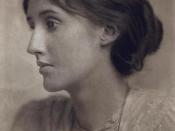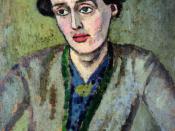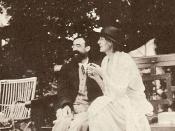"I adumbrate to a study of insanity and suicide: the world seen by
the sane and insane side by side." Virginia Woolf's description of
her intentions for Mrs Dalloway
By clarifying Mrs Dalloway as a story of insanity and suicide we are lead to presume that the focus of this novel will be 'insanity', a marginalized mental state. But Woolf subverts this social conception of mental instability, and writes instead a novel, which reunites insanity and society. By doing this she liberates insanity from its marginalized existence to portray insanity and society as mutually dependant, to the point of being almost indistinguishable. Michael Cunningham The Hours is a descendant of Mrs Dalloway; Cunningham attempts to readdress Woolf's concerns without the restrictions of historic censorship. As a result The Hours literally reside in a more externalised world; the increase in dialogue symbolises a reduction in taboo. Ironically however, I feel this novel gives a more restricted portrayal of mental states as Cunningham strives to understand and then universalise what it is to be insane.
By documenting the ongoing existence of 'insanity', Cunningham explores insanity as an inevitable part of society, his use of multiple narratives from three different time periods places emphasis on the idea that insanity is not just a freak occurrence in the course of history. In contrast, Virginia Woolf with a personal history of mental instability asserts and maintains the difference to be found among character's mental states. This difference is what allows Woolf's characters to "coalesce to become one existence" and thus she de-marginalizes insanity without excluding it.
Woolf moves throughout Mrs Dalloway through a community of minds. The novel is an "unbroken flow of perceptions" following one narrative. Woolf breaks away from the conventional structure of a novel, avoiding chapters and instead using the natural...



Good
good connections b/w the two texts.
thorough analysis.
2 out of 2 people found this comment useful.